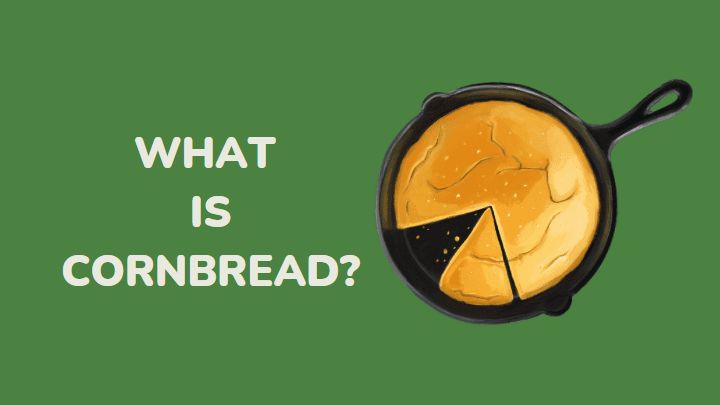If you’ve been at a Thanksgiving table, you certainly have heard of and maybe eaten cornbread. At first glance, you probably thought it was an unfrosted cake.
Although cornbread may not look so different or special, it is a legend in Native American cuisine. It dates as far back as the history of America and has become a Thanksgiving staple.
Beyond the plain look of this cornmeal product, there is a lot more you should know. Continue reading to see full details.
What is cornbread?
Cornbread is a cornmeal product. It is also called quick bread because it leavens quickly without the use of yeast. Traditional recipes use cornmeal, salt, and hot water, and may contain eggs.
However, in modern times, people include baking powder as a leaving agent in their recipes. Also, some recipes include all-purpose flour and oil.
Generally, recipes vary with families. According to personal preferences, some people make theirs sweet or savory. Moms hand over the family recipe to their daughters and granddaughters.
Essentially, this bread is made from simple ingredients that are readily available in stores and around the house. You may make your cornmeal at home with dried corn kernels or buy it from grocery stores.
Is cornbread bread or cake?
Cornbread is a type of bread, not a cake.
Although it may taste like cake depending on the ingredients it contains and the method of preparation.
What are the types of cornbread?
There are many types of cornbread, each having its specific method of preparation and ingredients.
They include Crackling Bread, Baked Cornbread, Johnnycakes, Corn Pone, Fried Corn Bread, Hot Water Cornbread, and Hushpuppies.
1. Baked cornbread
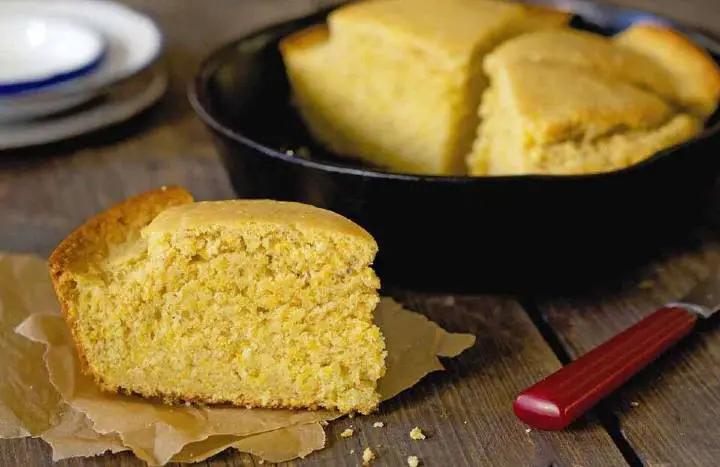
This is probably the first type of cornbread you’ll eat. If you’re from South America, you may find the Nothern American variety quite different.
The latter is sweeter and more cake-like because they use more eggs, sugar, and flour. In the South, the bread contains buttermilk and sometimes, pork rinds.
Generally, the preparation method starts with frying the batter in a skillet with oil. Afterward, it goes into the oven where it bakes into a moist cake.
2. Crackling bread
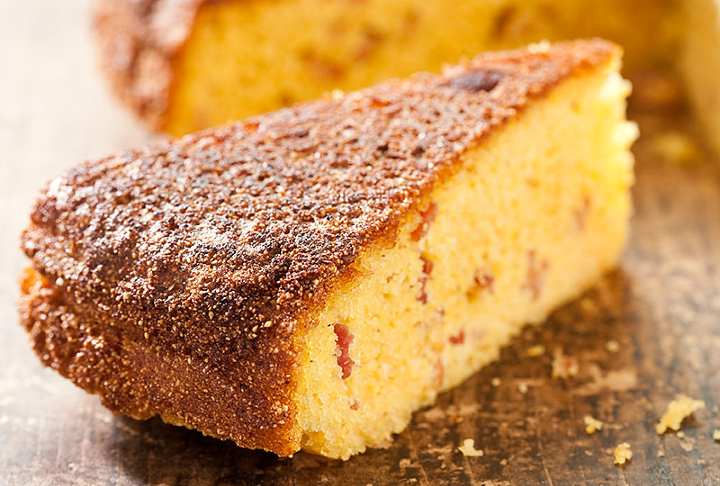
Crackling bread is a Southern American cornbread. The batter contains pork cracklings which give the bread its crunchy mouthfeel
In addition, you can prepare this bread using any preparation method, but the most common method is with a skillet which makes it crispier.
3. Hushpuppies
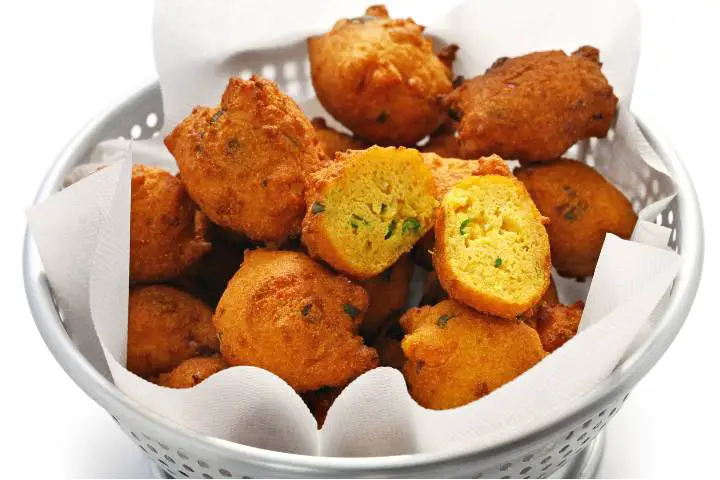
Hushpuppies use a thicker buttermilk-based batter that you deep-fry instead of making in pan-fried forms. The crispy, golden brown skin encloses a moist, yellow interior.
Although the recipes vary from state to state, hushpuppies are unique for their savory taste. For example, some use jalapeños, chopped onions, beer, or onion seasoning in their recipes.
4. Hot water cornbread
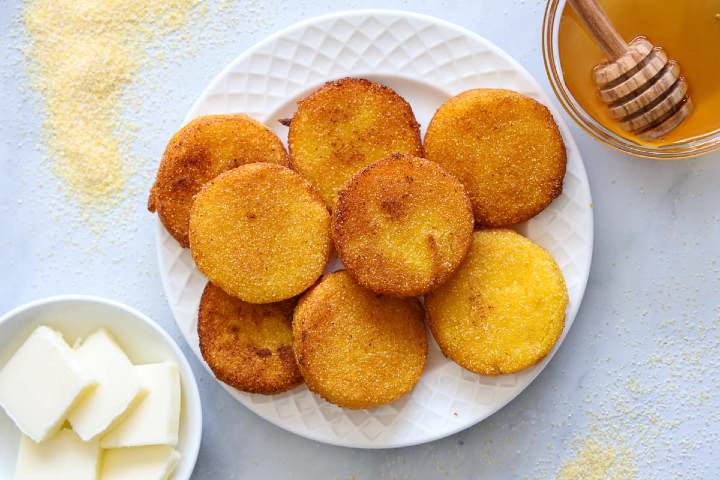
Known as “scald meal” or “hot water”, this is a South American variation of the quick bread. The preparation method involves frying small portions of the batter in hot oil.
The end products are 3 or 4″ pieces of bread with medium or light golden and crunchy skin that encloses a soft, squashy inside.
Hot water cornbreads are usually dipped in honey to enhance the taste. Also, some recipes include wheat flour to make it more bread-like.
5. Corn Pone
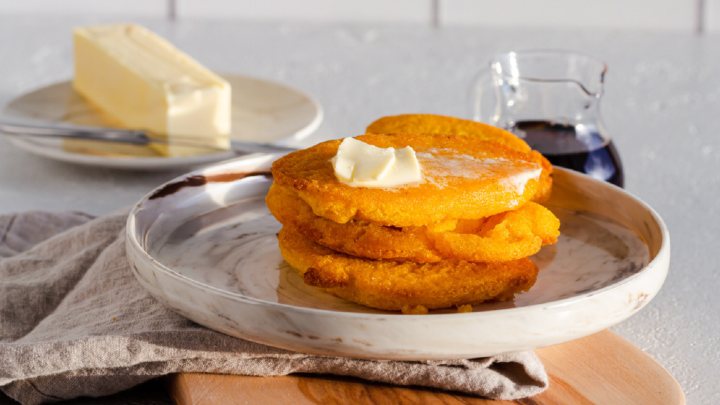
Sometimes called Indian Pone, corn pone is another variety of this quick bread made from a thick dough that does not contain egg or milk.
The bread is cooked with cooking oil, shortening, or butter in an iron pan over an open fire.
6. Johnnycakes
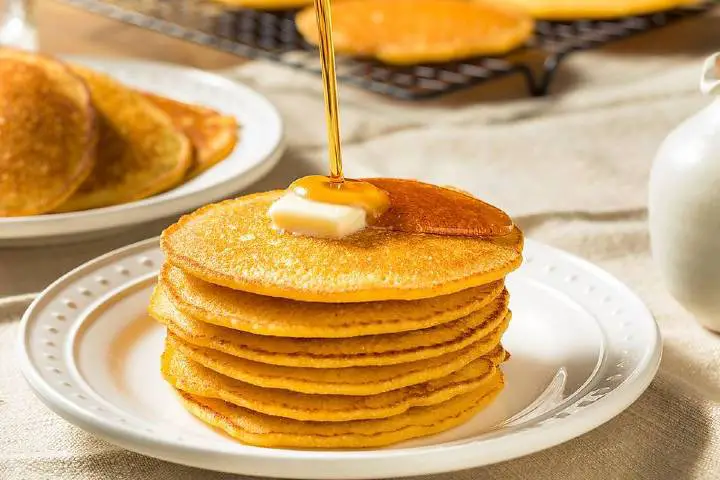
Hoecake, Johnny Bread, or Johnnycakes are different names some people call this bread. The preparation method involves frying a thin cornmeal batter in a skillet or a griddle to make flatbread.
Based on personal preferences, the recipe may include leavening agents, butter, or eggs.
7. Fried cornbread
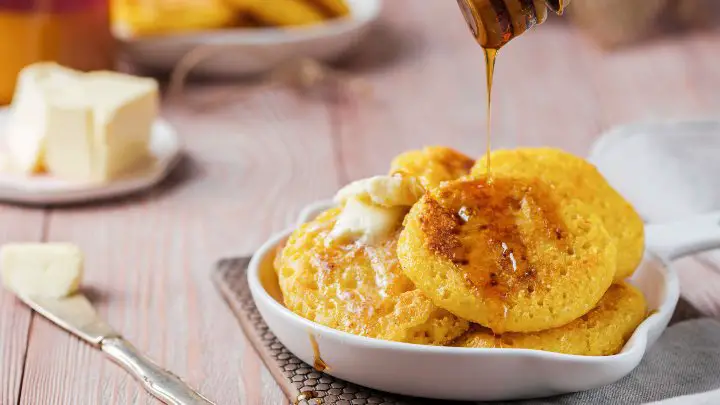
Frybread or fried cornbread originates from the Lumbee Tribe of North Carolina. It’s their special way of making cornbread.
They make their batter with egg, salt, buttermilk, and yellow cornmeal. Then, they fry it in small portions to make thin, crunchy bread.
Nutritional value of cornbread
According to the USDA, one piece of cornbread contains:
- 198 calories
- 6g fat
- 7g protein
- 33g carbohydrates
- 10g sugar
- 1.4g dietary fiber
- 34.2mg cholesterol
- 359.4mg sodium
- 79.8mg potassium
- Calcium – 8% DV
- Iron – 6% DV
- Other vitamins and minerals
What are the health benefits of cornbread?
Cornbreads contain fiber
Cornbread comes from corn and is classified as a whole-grain food. Whole-grain foods contain a sufficient amount of fiber that helps lower blood sugar levels, absorb cholesterol, and regulate bowel movements.
Also, because the fiber merely passes the digestive system and does not get digested, so it doesn’t increase calories. However, it still helps to make the bread filling.
It is rich in nutrients
Cornbread contains many nutrients like magnesium, folic acid, iron, folate, phosphorus, vitamin A, vitamin B6, Vitamin B12, and potassium. These nutrients support and enhance brain health and boost immunity.
Great source of protein and antioxidants
This bread contains all the 10 essential amino acids that are necessary for controlling cellular processes, organ functions, and growth.
Furthermore, cornbreads are rich sources of antioxidants. The presence of antioxidants in cornbreads may also help slow down the aging process and reduce the risk of heart disease, stroke, or cancer.
What are the disadvantages of eating cornbread?
Generally, you may suffer side effects if you have corn intolerance, which is not common.
However, based on the recipe, type of cornmeal, and method of preparation, the bread may contain high amounts of sugar, sodium, refined grains, and animal fats.
Excess consumption of these substances can be harmful to your health. For instance, excess consumption of sodium can increase blood pressure and the risk of heart problems.
When the bread contains refined grains, it could cause obesity and predispose you to inflammation and adverse health conditions.
In a case where it contains animal fat, it could cause cholesterol to build up and clog the arteries.
FAQs
Is cornbread gluten-free?
Traditional cornbread is gluten-free because it is made with only cornmeal. However, if you buy commercial cornmeal, it may contain gluten flours.
If you have gluten sensitivity, avoid store-bought cornmeal or look for brands that do not add gluten flours to their cornmeal.
Is cornbread better than bread?
Yes, it is.
When you look at the nutritional value of the two types of bread, you’ll find that cornbread is a healthier option for everyone.
For instance, white bread contains high amounts of calories when compared to cornbread.
What does cornbread taste like?
Cornbread tastes like corn. It could taste savory or sweet, depending on any other ingredient your recipe contains.
Are corn muffins the same as cornbread?
No, they are not.
You can make cornbread to take the shape of muffins, but it is essentially made with cornmeal like other cornbreads.
On the other hand, corn muffins are muffins made with corn, cornmeal, and lots of sugar.
Is cornbread a side or dessert?
Cornbreads can be anything you want them to be.
If you want it to be a side dish, make it savory or serve it with chili or soup. If you want it as a dessert, add a lot of sugar to your recipe or serve it with something sweet.
Conclusion
Cornbread is a meal made from cornmeal. The cornbread you eat may differ with the region of America you live in.
Essentially, it is made with corn. A good thing about this staple is that you can own your recipe. Moreover, it is easy and simple to make.
So, you know what you’re eating when next you’re at a Thanksgiving table. Also, you now have an idea of the different types of cornbread, and you can treat your guests to something different.
Thanks for reading.
Visit Millenora to read more informational articles like this.
